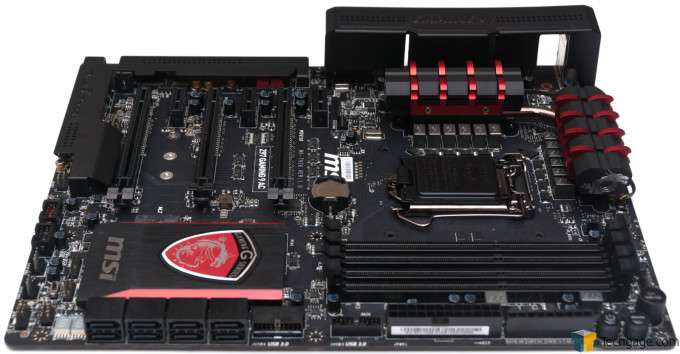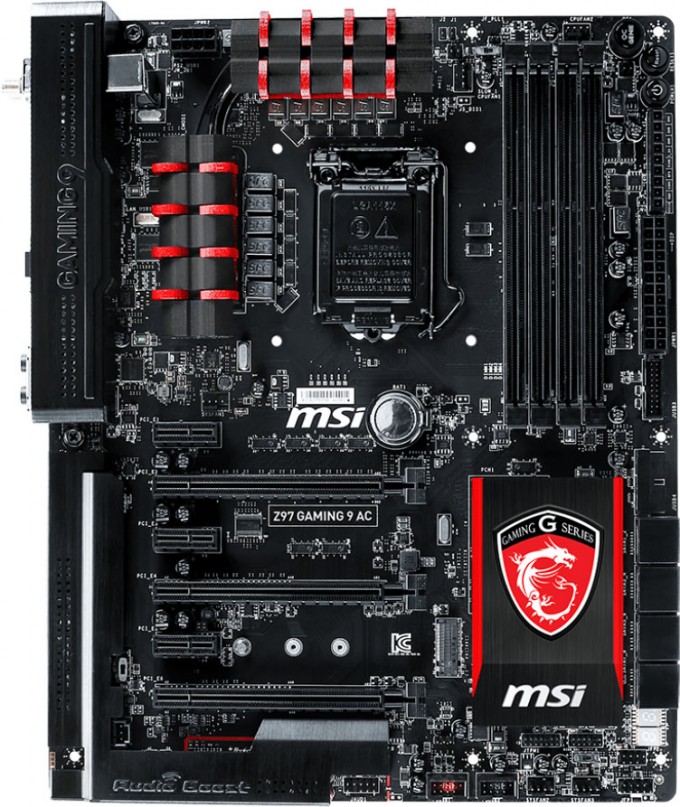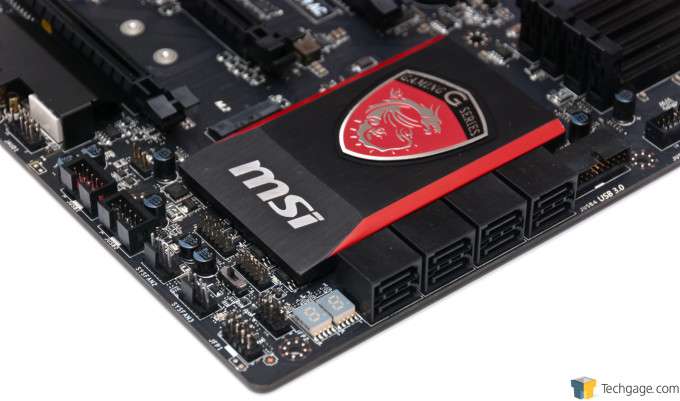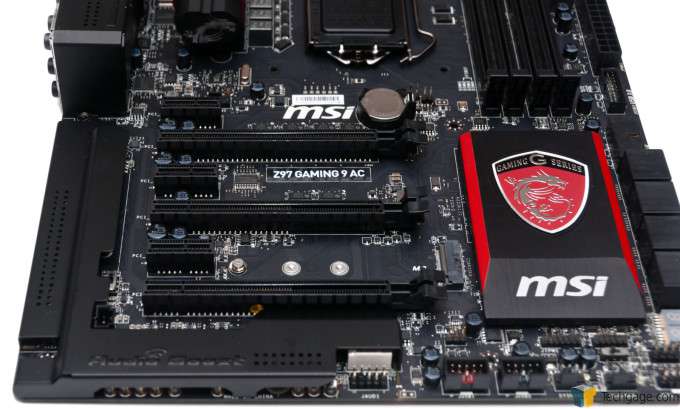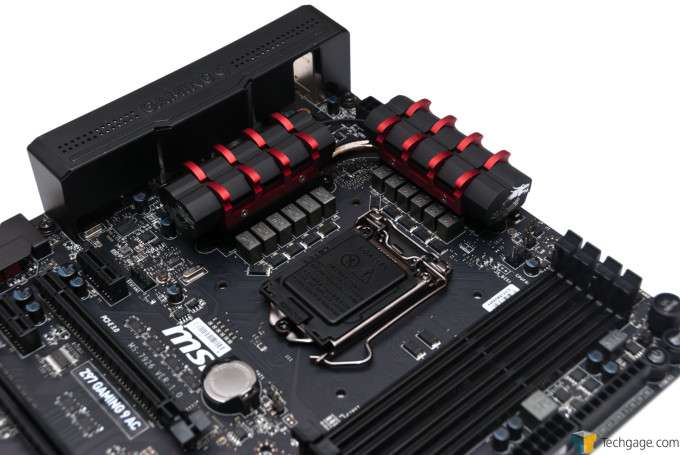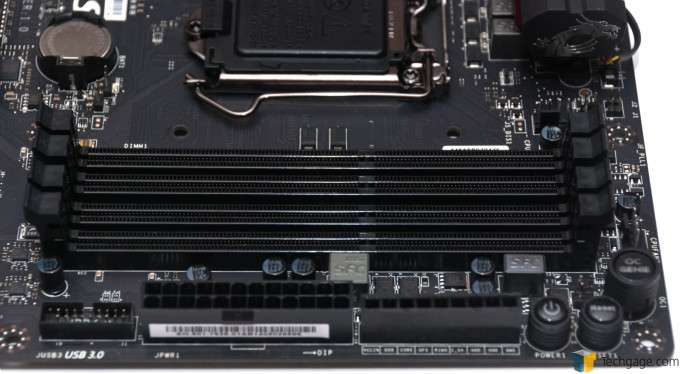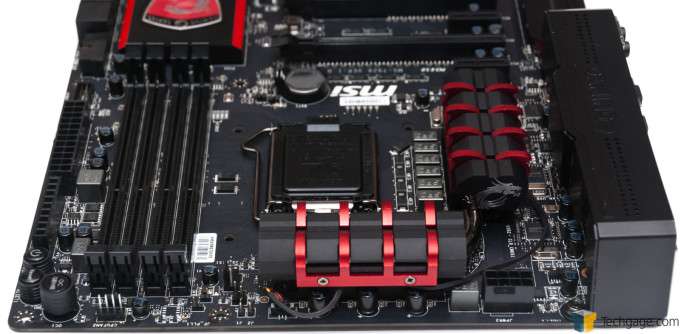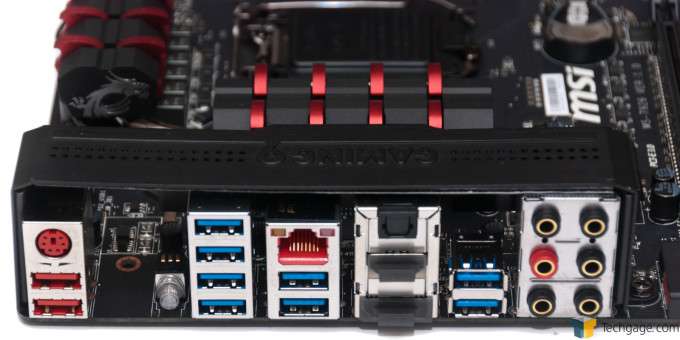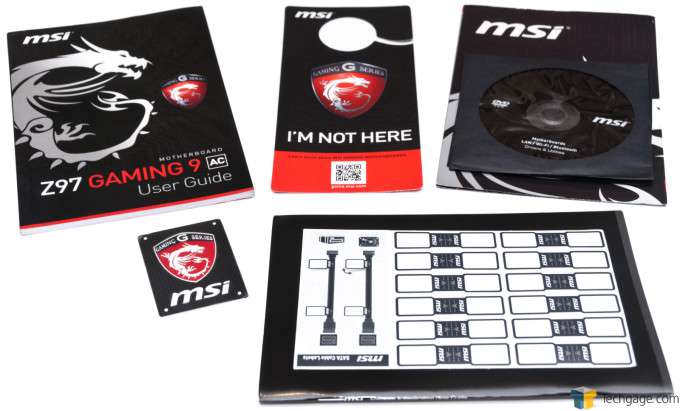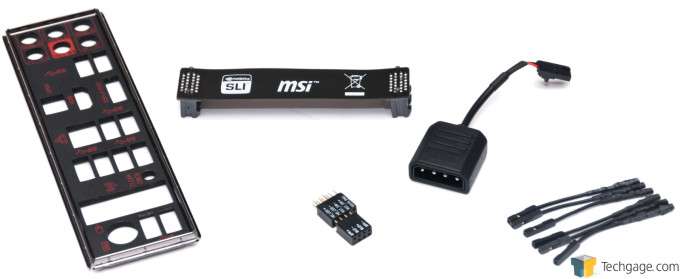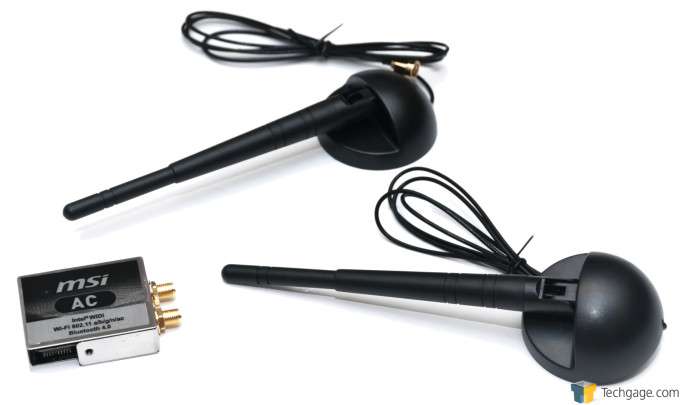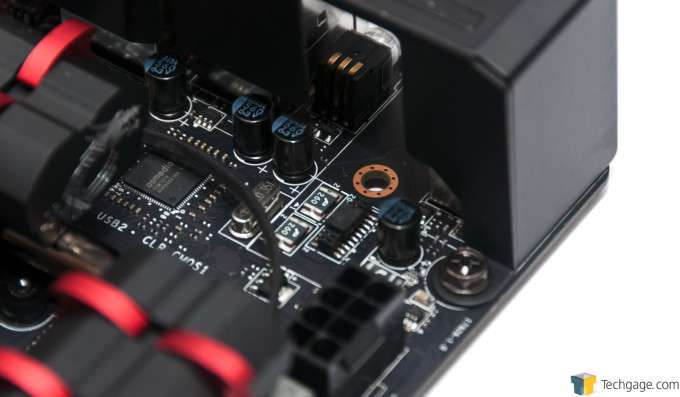- Qualcomm Launches Snapdragon 4 Gen 2 Mobile Platform
- AMD Launches Ryzen PRO 7000 Series Mobile & Desktop Platform
- Intel Launches Sleek Single-Slot Arc Pro A60 Workstation Graphics Card
- NVIDIA Announces Latest Ada Lovelace Additions: GeForce RTX 4060 Ti & RTX 4060
- Maxon Redshift With AMD Radeon GPU Rendering Support Now Available
MSI Z97 Gaming 9 AC Motherboard Review

The last time we took a look at an MSI gaming motherboard, it was the company’s smallest current offering: Z97I Gaming AC. For this review, we’re looking to the top of the Z97 ladder, with the Z97 Gaming 9 AC. Priced at about $290, it’s easy to predict what this board might bring to the table, but all told, it still managed to impress us.
Page 1 – Introduction, Specifications & Hardware Tour
In August, I took a look at MSI’s Z97I Gaming AC, a mini-ITX motherboard that while small, proved to be very mighty. As far as MSI’s Z97 gaming offerings go, that model finds itself at the bottom of the ladder, whereas the board that I’m looking at here, Z97 Gaming 9 AC, enjoys a sweet view from the top.
The Gaming 9 AC’s price hovers around the $300 mark, but I’ve seen it dip as low as $270 when mail-in rebates are brought into the equation. Given its price-point, you can likely expect what kind of feature set the board brings to the table, and you’d be spot-on if you guessed that this was one very robust offering.
This board’s aesthetics helps distinguish itself as a gaming board right out-of-the-gate, but it’s of course the feature set that matters, not its pretty face. Included here is advanced networking via Killer Ethernet as well as a full assortment of audio toys. The board even includes a six-month subscription to XSplit Gamecaster, a game recording suite. I’ll talk more about these features later, but for now, let’s get into the hardware.
With its black and red color scheme, MSI’s Gaming 9 AC definitely fits the bill as a gaming motherboard (as if its name didn’t solidify that fact enough already). Even on the gaming front, though, it’s not often that we see so much shielding as we do here. Not only does the audio portion at the bottom left-hand side of the board have shielding, but so does the I/O panel. Does this shielding matter for the performance or quality of the board? Nope – not at all. It looks great, though.
| MSI Z97 Gaming 9 AC | |
| Architecture | Intel Z97 (LGA1150) |
| Form-Factor | ITX (12″ x 9.6″) |
| Memory | Up to 4x8GB DDR3-3300 |
| Multi-GPU | 2-way NVIDIA SLI 3-way AMD CrossFire |
| Expansion | 3x PCIe 3.0 x16 3x PCIe 2.0 x1 |
| Storage | 6x SATA 6Gbps (Intel) 2x SATA 6Gbps (ASMedia) 1x M.2 |
| Network | 1x Killer Ethernet (E2205) Gigabit |
| Wireless | Wi-Fi 802.11 a/b/g/n/ac (Intel 7260) Bluetooth 4.0 |
| Audio | Realtek ALC1150 8-channel Optical S/PDIF out |
| USB | Back-panel: 8x USB 3.0 (ASM 1074 & 1042), 2x USB 2.0 (Intel) Internal: 4x USB 3.0 (Intel), 4x USB 2.0 (Intel) |
| Back I/O | 1x 1Gbps LAN, 8x USB 3.0, 2x USB 2.0, 1x Optical S/PDIF, 6x Audio Jacks, 1x HDMI, 1x DisplayPort, Wi-Fi connector, PS/2 |
| Features | Audio Boost 2, USB Audio Power, Xtreme Audio DAC, XSplit Gamecaster, SteamOS-ready, Killer E2200 Gamer Networking, Guard-Pro, OC Genie 4, Click BIOS |
Most of the Gaming 9 AC’s specs are standard fare, such as its support for up to 32GB of memory, as well as its multi-GPU support. It doesn’t take too much digging to see what sets this board apart from most others, though.
At the forefront, the board includes Qualcomm’s Killer Ethernet E2205 networking. Personally, I am not a fan of Killer Ethernet, and hate to see it included on boards as the only LAN offering, but my ire boils down to past experiences, and I’d hope that nowadays, it’d behave itself over the long-run. Do note that if you plan to use Linux with this board, you might have to get a little hands-on with getting this networking to work. If SteamOS is your plan, then you should have no issues at all.
For audio, the board includes a typical Realtek chipset, but has other features piled on to improve the offering overall. This includes the audio portion of the board being isolated, along with the ability to tap into a dedicated power input via Direct Audio Power. With MSI Audio Boost 2, the company promises top-rate sound quality, and for headphones users, you can be rest-assured that even with headphones rated at up to 600ohms, you’ll have no problem taking full advantage of them thanks to the board’s dual amplifiers.
With all of that covered, I think it’s time for our hardware tour.
A Hardware Tour of MSI’s Z97 Gaming 9 AC
MSI’s Z97 Gaming 9 AC is a standard-sized ATX motherboard, and if you’re so inclined, you’ll be able to easily install 3 graphics cards for CrossFire use, thanks to the slack left underneath the bottom slot. If you’re more interested in NVIDIA SLI, you’ll unfortunately be limited to 2 GPUs, but given the throttled-back PCI bandwidth versus a more robust chipset like X99, 2 GPUs should be plenty enough for anyone with this board.
For a board of this price range, I like to see at least 6 fan headers, but this one includes just 5. Whether or not that’s an issue is dependent on your installation – I’d just like to see as many as possible since some people do like to load their rigs up with fans. But while I would have liked to have seen 6, the 5 here are at least arranged well, with dual CPU headers at the top, two more at the bottom, and one to the left of the CPU socket.
We’ll get more into the nitty gritty with the following images, starting with a look at the bottom right-hand corner, which shows the various internal connectors that most people will rely on, as well as the 8x vertically-mounted SATA ports.
It’s kind of easy to miss, but directly to the right of the SATA arrangement is one of the board’s USB 3.0 headers. Like the SATA ports, this is also horizontally-mounted. To the right of that connector is another USB 3.0, which happens to be vertically-mounted. Also worth noting in this shot is that the board includes an LED BIOS readout – a big plus in my book.
Moving on over to the expansion slot section, we can see the 3x PCIe x16 slots as well as the 3x PCIe x1 slots. As mentioned above, using three GPUs will be no problem here, and if you do go that route, you’ll have a single x1 slot remain at the top. I appreciate this design, because MSI could have easily changed the arrangement here and made it so that not even a single x1 would be left over if you were to use that many GPUs. Given some of the bizarre design choices I saw on the Z97I Gaming AC, I wouldn’t have even been surprised if that were the case.
At the top of the board we can see a fairly clean area around the CPU socket, as well as some attractive heatsinks and arrangement of super ferrite chokes. If you look close at the side of the heatsinks pictured below, you can see the dragon logo that’s been gracing MSI’s gaming boards for some time.
Sometimes, the top right-hand corner of a motherboard can be boring, but not here. As mentioned earlier, this board supports up to 32GB of memory, and speeds of up to DDR3-3330. To the left of the 24-pin power connector here is the second USB 3.0 header, and opposite of the power connector is “V-Check Points 2”, a set of eight points for overclockers to monitor with their multi-meters. Power, reset, and OC Genie buttons can be found here, as well.
While not the most important angle of a motherboard, I do like including a top-view shot to give you an idea of what it’ll be like to build with this board. There’s really nothing to point out in this instance, except for the fact that I appreciate MSI’s (and any vendors’) decision to orient the 8-pin power connector as seen here, rather than up and down – it tends to make installation a wee bit easier.
For our last stop on this tour, we take a look at the I/O panel. The USB 3.0 ports are powered by two different ASMedia chipsets, 1074 and 1042, though their differences were indistinguishable to me. While those ports are not too special, the dual USB 2.0 ones (red) are. These use three times the amount of gold as the other connectors, and promise a tenfold lifespan when unplugging / replugging. MSI dubs these “gaming ports”, because of their higher quality. Since peripherals are fine to plug into USB 2.0 anyway, you might as well take advantage of them, even if their benefits sound like marketing fluff.
Time for a look at the accessories. MSI includes a variety of documentation here, along with a driver DVD. Because drivers update often, I’d recommend heading to the main support website instead to get up-to-date, unless you’re fine with using the disc’s finicky installer. A couple of included bonuses can be seen in this shot: A doorknob tag, a case badge, and cable labels – all a very nice touch.
If those bonuses are not interesting enough, some of the other accessories should take care of that. Seen below is the I/O panel we’ve come to expect (which looks quite good, honestly), an SLI 2-way bridge, M-Connectors (for making the plugging in of the chassis connectors easier), along with an audio power adapter and “V-Check” cable.
I mentioned earlier that this board includes the ability to tap directly into the power to improve your audio, and that’s where this adapter comes into play. With it, you connect a Molex power connector to one end, and then the other 4-pin end to a special connector on the motherboard. The V-Check cable essentially makes it easier for overclockers to make use of the board’s voltage readouts – yet another nice touch.
Out-of-the-box, the Gaming 9 AC doesn’t have Wi-Fi support. To enable it, you’ll need to install the included module, and then connect the antennas, both seen in the shot below.
The Z97I Gaming AC board I took a look at months ago had the exact same Wi-Fi module, and I noted that while it isn’t the best solution, it’s not too hard to install and secure. Well, I found the solution with this board to be more tedious, because the connector you must plug this module into is harder to get at – thanks both to the I/O shield and the fact that neither side of it is free and clear of intrusive components. You’re going to need some patience here. With the shot below, you can probably grasp the potential hassle when you compare the size of the Wi-Fi connector to the 8-pin power connector. As someone with sub-par eyesight, getting that sucker installed was not fun.
Phew, with that all out of the way, it’s time to check out the board’s EFI and software.
Support our efforts! With ad revenue at an all-time low for written websites, we're relying more than ever on reader support to help us continue putting so much effort into this type of content. You can support us by becoming a Patron, or by using our Amazon shopping affiliate links listed through our articles. Thanks for your support!




